


In the days of GV Black dentistry, the watch and wait approach actually had a tremendous amount of merit. Clinicians, at times, were able to diagnose caries at an early stage; however preparation form for amalgam restorations did not lend themselves to conservative dentistry. Even if caries were diagnosed at an early stage, a significant amount of tooth structure would need to be removed, simply to retain these restorations. Over the last decade, numerous technologies have come to market allowing practitioners to discover caries at the early stage, and the practitioner now has the ability to treat this disease through remineralization protocols or minimally invasive surgical intervention.
If a practitioner chooses to remove the caries surgically from the tooth, they must focus on creating a conservative preparation form and maintain as much tooth structure as possible. Resin restorations do not require specific preparation parameters and the goal with these restorations is simply to remove the decay. In the past, the bur of choice for operative preparations was a 557 or 330 bur. While decay can most definitely be removed with these burs, unfortunately, an extensive amount of healthy tooth structure is also unnecessarily removed due to the relative large size of these burs. In this day and age, one must consider using the smallest instrument possible. Hard tissue lasers and air-abrasion units can offer a conservative means for caries removal; however, these devices require a large to moderate investment in equipment and the workflow can become more complicated than necessary. A simpler solution may be to simply opt for innovative and cost efficient smaller burs that have been designed for conservative restorations. These burs tend to have appropriate cutting efficiency, yet they are nearly 70% smaller than traditional operative burs.
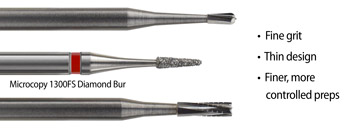
One particular bur that accomplishes this task is the 1300 FS bur by Microcopy (See figure at left.) It is a diamond-coated bur with a tapering cutting surface. This shape allows for conservative excavation of a carious lesion at the tip of the bur while creating a funnel effect as caries are removed with deeper bur penetration. The small tip diameter allows for minimal preparations to occur many times without the need for pulpal anesthesia. In addition, the funneling effect allows proper visualization while creating a path for proper adhesive and flowable resin placement. Flowable composites have improved drastically over the last few years and many flowable composites now have physical properties that rival traditional hybrid composites just a few years ago.
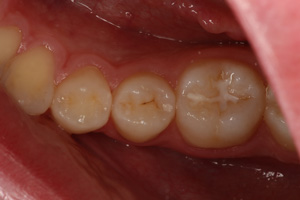
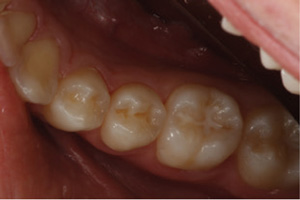
Image 1
In the clinical case depicted, the patient presented with occlusal caries on the lower left second bicuspid. The primary carious lesion was centered in the distal pit with early caries present in the mesial pit. See Image 1. The decay was removed in both of these areas with no anesthesia while utilizing a 1300 FS bur.
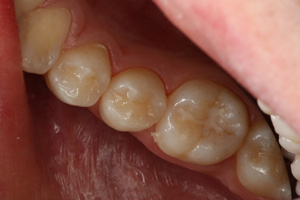
Image 2
After caries removal and proper isolation (Isolite), the tooth was restored with a highly filled flowable composite (Gaenial Universal Flow). See Image 2. The patient was happy that the carious tooth was restored in an efficient manner with zero discomfort and that a vast majority of healthy tooth structure was maintained.
The combination of innovations in rotary instrumentation and resin materials allows clinicians to provide minimal intervention with maximum effectiveness.
Parag R. Kachalia, DDS
Vice Chair: Simulation, Technology, and Research
Associate Professor of Reconstructive Dentistry
Department of Integrated Reconstructive Dental Sciences
Arthur A. Dugoni, School of Dentistry
University of the Pacific
Microcopy
P.O. Box 2017
Kennesaw, Ga 30156-9017
P: 800.235.1863
F: 770.423.4996
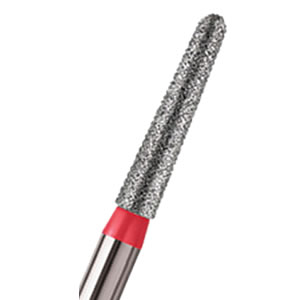
011M (Ball) 25 Pack
QTY: 2
X
$97.00

011M (Ball) 25 Pack
QTY: 2
X
$97.00
STANDARD TERMS AND CONDITIONS OF SALE
SPECIAL EXPORT TERMS AND CONDITIONS OF SALE
RETURNS POLICY
Microcopy will accept returns from US and Canada direct customers once an approved Return Authorization number has been recorded. All returns older than 1 year will require a 15% restocking charge. No returns will be accepted after 3 years from original ship date. All shipment of goods outside of the continental US is final.
REMOVE

0110M (1)
Medium Grit
25/PK
$48.50
Reference F/G | 801-018 |
Head Diameter | 1.8 mm |
Head Length | 1.6 mm |
Overall Length | 19.2 mm |
Reference F/G
801-018
Head Diameter
1.8 mm
Head Length
1.6 mm
Overall Length
19.2 mm
No other grits offered for this shape
REMOVE

0112M (2)
Medium Grit
25/PK
$48.50
Reference F/G | 801-018 |
Head Diameter | 1.8 mm |
Head Length | 1.6 mm |
Overall Length | 19.2 mm |
Reference F/G
801-018
Head Diameter
1.8 mm
Head Length
1.6 mm
Overall Length
19.2 mm
No other grits offered for this shape
REMOVE

0116C (4)
Coarse Grit
25/PK
$48.50
Reference F/G | 801-018 |
Head Diameter | 1.8 mm |
Head Length | 1.6 mm |
Overall Length | 19.2 mm |
Reference F/G
801-018
Head Diameter
1.8 mm
Head Length
1.6 mm
Overall Length
19.2 mm
Medium (0116M)
![]() Bridge/Operative
Bridge/Operative![]() Ball
Ball![]() Beveled Cylinder
Beveled Cylinder![]() Dbl Inverted Cone
Dbl Inverted Cone![]() Egg
Egg![]() End Cutter
End Cutter![]() Flame
Flame![]() Flat End Cylinder
Flat End Cylinder
![]() Flat End Taper
Flat End Taper
![]() Mod. Flat End Cylinder
Mod. Flat End Cylinder
![]() Interproximal
Interproximal
![]() Football
Football
![]() Gross Reduction
Gross Reduction
![]() Inverted Cone
Inverted Cone
![]() Mod. Bevedled Cylinder
Mod. Bevedled Cylinder
![]() Mod. Flat End Taper
Mod. Flat End Taper
![]() Occlusal Reduction
Occlusal Reduction
![]() Pear
Pear
![]() Occlusal Reduction
Occlusal Reduction
![]() Depth Cutter
Depth Cutter
![]() Endo
Endo
![]() End Cutting
End Cutting
![]() Finishing
Finishing
![]() Guide-Pin
Guide-Pin
![]() NeoSpiral
NeoSpiral

0110M (1)
Medium Grit
25/pk
$48.50